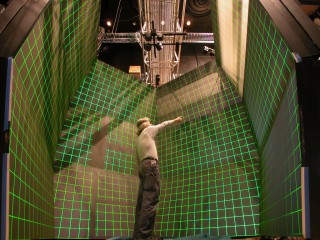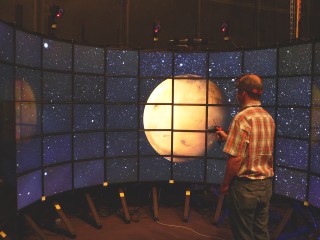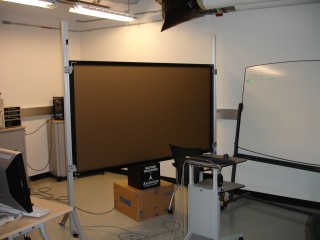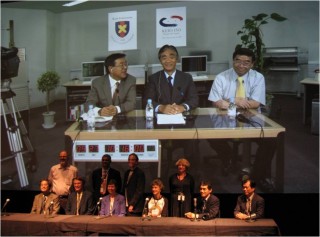From Immersive Visualization Lab Wiki
StarCAVE
 |
The StarCAVE consists of five walls with three screens each, plus a floor we project on. Two JVC HD2K projectors generate a stereo image for each screen, plus four projectors for the floor, totalling 34 projectors in the StarCAVE. Every projector pair is driven by an Intel quad core Dell XPS computer running under ROCKS/CentOS, with dual Nvidia Quadro 5600 graphics cards. We use an additional XPS machine as the head node to control the rendering cluster, for a total of 18 nodes. For user tracking and interaction we use a wireless, optical tracking system by ART Tracking. It consists of four IR cameras and a Flystick2 3D joystick. We currently support two software environments to drive the StarCAVE: COVISE and Electro. The StarCAVE is located on the first floor of Atkinson Hall in room 1608a.
|
Varrier
 |
The Varrier wall consists of 60 LCD monitors, arranged in a semi cylinder. It displays autostereoscopic images, which means that the user can see 3D without glasses. The resolution of the wall is roughly 40 million pixels per eye. The system consists of 16 dual AMD Opteron workstations, each equipped with 4GB RAM, 2.0 TB RAIDed disk arrays, dual gigabit ethernet network ports, and dual Nvidia Geforce 7900 video cards. Each rendering node drives four 20" NEC LCD monitors at 1600x1200 pixels per screen, totalling 155.2 million pixels on the entire wall. The operating system is Suse Linux 10.0. We support two software environments to drive the Varrier: Electro and COVISE. For head tracking and user input we use a wireless, optical tracking system from Advanced Realtime Tracking (ART) with a Flystick2 3D joystick. The Varrier is located on the first floor of Atkinson Hall in room 1608a.
|
Virtulab
| The Virtulab is a dynamic visualization laboratory, which currently houses a NexCAVE, REVE, SAGE wall, and a LifeSize video-teleconferencing (VTC) device. Funded by a partnership with King Abdullah University of Science and Technology (KAUST), the Virtulab serves as a working prototype environment for many KAUST visualization areas. Collaboration between Calit2 scientists at UC San Diego, the Electronic Visualization Laboratory (EVL) at the University of Illinois at Chicago, and KAUST allows for ongoing and continuous research in 2D, 3D, and auto-stereo visualization.
|
C-Wall
 |
The C-Wall (configurable wall) is a dual screen, flat 3D display, driven by a Dell XPS computer with dual Nvidia Quadro 5600 graphics cards, running under CentOS Linux 5.3. The computer drives four JVC HD2k projectors with a resolution of 1920x1080 pixels (HD), projecting on a 8 by 8 foot screen from the rear. We use circular polarization filters to separate the stereo images. For tracking we use an electro-magnetic Ascension Flock of Birds system with head tracking and a Wanda input device. The concept of the C-Wall is described here. The software driving our C-Wall is COVISE. The C-Wall is located on the sixth floor of Atkionson Hall in room 6307.
|
Digital Theater
 |
Calit2's digital theater offers 200 seats with power and ethernet jacks in every seat. The high end technical equipment installed in this room allows it to be used for anything ranging from presentations with Powerpoint slides, video screenings, presentations of visual and performance art, to demonstrations of the future of digital cinema: 4k video on a 18 by 32 foot screen. Among the technical highlights of the auditorium are: a 20 channel surround sound system, high definition (HD) video playback from computers or digital HD tapes, real-time virtual reality with a 3D tracking system, and a Sony SRXD-R110 4k projector (4096x2160 pixels resolution). The control room houses the following 4k-relevant hardware:
- An NTT hardware codec, which can play back JPEG2000 compressed 4k video with multi-channel audio at 24 or 30 frames per second.
- A Zaxel video server with lossless compression to playback and record 4k video.
- A Dell XPS workstation with dual Nvidia Quadro 5600 graphics cards, which allows for real-time computer graphics in 4k. We use an Ascension Flock of Birds tracker with a Wanda input device on the show floor to interact with the virtual environment.
Other equipment used in the digital theater includes a digital light mixer, a conventional projector by Christie with a resolution of 1600x1200 pixels, and a remote control system by Crestron which allows presenters to connect their laptops and control video and audio directly from the podium.
|



